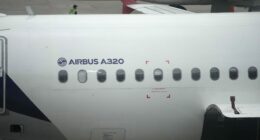Share this @internewscast.com
Damage scanners are taking over more rental car return lots — and customers aren’t happy.
Since Hertz rolled out AI scanners in April, it has faced backlash for charging almost $1,000 for tiny scuffs.
Now Sixt, a premium rival with 100 locations in the US, has in recent weeks begun using a similar tool called Car Gate.
Currently, this technology is causing issues. A customer recounted to The Drive that after returning a Mazda CX-50 at Atlanta’s Hartsfield Airport, he was charged $605.82 for wheel damage.
Documents sent to the renter showed that the damage occurred before the rental period.
‘They were using the wrong photo,’ Badi said. ‘After escalating to management, they dropped the claim entirely.’
Sixt scans each rental car when the driver picks it up and again when return it — with a powerful computer highlighting even the slightest damage.
Concerns exist that Avis might implement similar technology. Meanwhile, Enterprise, which owns National and Alamo and is the largest rental firm in the USA, is already experimenting with it in Europe.

More rental companies are turning to AI-enabled scanners to spot damage on cars and charge customers
Supporters of vehicle scanning technology argue that it enhances safety by detecting problems like tire wear and undercarriage damage more effectively than human inspections.
Sixt told Daily Mail: ‘Our customers value transparency — and we take that seriously.
‘We sincerely apologize for any inconvenience to the customer. This experience does not reflect our high service standards.’
The Daily Mail asked the company twice if the fees paid by customers are used to fund vehicle repairs rather than boost profits. Sixt didn’t respond.
Hertz introduced damage scanners in April. Since then, six customers have informed the Daily Mail of encountering similar charges for minor dents identified by scanners developed by the AI startup UVeye.
‘It’s a shakedown that is extremely off-putting,’ Adam Foley, a driver who received a $285 charge for two small spots, said.
Unlike Sixt, which employs humans to review all damage scanner fees, when Foley attempted to dispute the charge, Hertz only offered a chatbot.
Every Hertz customer has said the chatbot offered lower damage rates if they paid the fine immediately.

Drivers complained about new technology rollouts at rental car companies

The AI scanner picked up two small ‘dents’ on Foley’s Buick rental
‘This basically seems like a money-grabbing exercise by Hertz,’ Neil Saunders, a retail expert at GlobalData, said.
‘If there is no way to discuss with a human, then that is also extremely poor customer service.’
Foley isn’t the only one affected. Other customers have faced charges such as $440 for a minor wheel scuff, $190 for small dents, and $935 for barely noticeable blemishes.
Dr Ramnath Chellappa, a technology scholar who coined the term ‘cloud computing,’ said the AI-based scanners aren’t being used ethically.
‘AI should, if anything, reduce the human effort required in assessments and vehicle walk-throughs,’ he commented. ‘It should ultimately provide cost savings.’
Since July 2, DailyMail.com has asked Hertz representatives six times to clarify whether damage charges fund actual repairs or compensate for diminished vehicle value.
Hertz declined to comment on the record and did not directly answer whether fees collected from customers are always used to fund repairs.

A driver said they were charged $190 by Hertz for this damage on a returned vehicle
Meanwhile, other major rental firms are testing AI scanners into their vehicle lots.
Avis has previously said that a majority of its damage assessments remain ‘human-led,’ but hasn’t explained what that means.
The company did not respond to Daily Mail’s request for comment.
Meanwhile, Enterprise said it does not use computer-powered inspection tools in the US.
‘There are some limited instances, such as the Berlin and Munich airports, where this technology is being implemented airport-wide,’ a spokesperson told the Daily Mail.
‘But we are not utilizing this technology without an internal review of the image capture.’
















